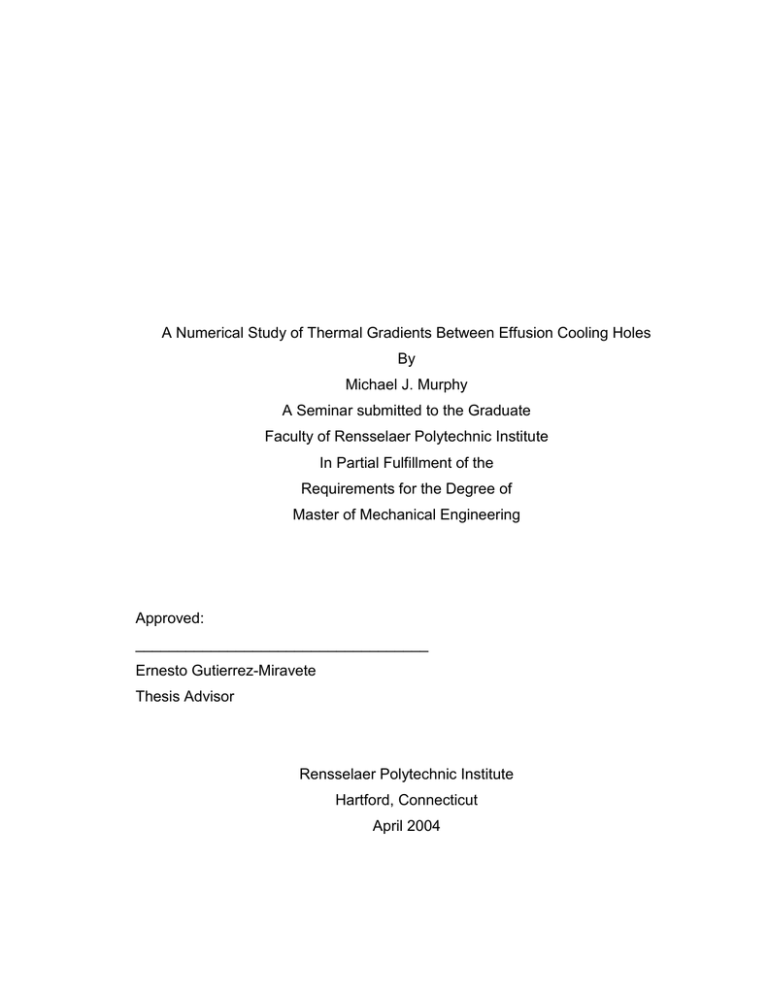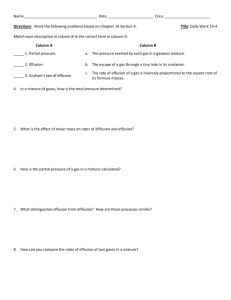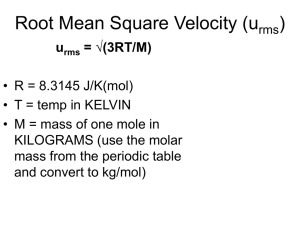A Numerical Study of Thermal Gradients Between Effusion Cooling Holes By
advertisement

A Numerical Study of Thermal Gradients Between Effusion Cooling Holes By Michael J. Murphy A Seminar submitted to the Graduate Faculty of Rensselaer Polytechnic Institute In Partial Fulfillment of the Requirements for the Degree of Master of Mechanical Engineering Approved: ___________________________________ Ernesto Gutierrez-Miravete Thesis Advisor Rensselaer Polytechnic Institute Hartford, Connecticut April 2004 Table of Contents: Table of Contents: ............................................................................................................... ii List of Tables: .................................................................................................................... iii List of Figures: ................................................................................................................... iv Nomenclature / Symbols Used: .......................................................................................... v Acknowledgements: ........................................................................................................... vi Abstract: ............................................................................................................................ vii 1. Introduction / Historical Review:................................................................................ 1 2. Method of Procedure: ................................................................................................. 2 3. Background information and Geometric Explanation: ............................................... 2 4. Analysis: ..................................................................................................................... 3 5. One Dimensional Analysis: ........................................................................................ 5 6. Finite Element Model: ................................................................................................ 6 6.1. Symmetry Model Results:................................................................................... 8 6.2. Convergence of the Finite Element Model: ........................................................ 9 7. Generation of the Test Matrix:.................................................................................. 12 8. Results:...................................................................................................................... 15 8.1. Comparison to Design Cases: ........................................................................... 16 8.2. Comparison to Design and Off Design Cases: ................................................. 18 9. Discussion / Conclusions: ......................................................................................... 18 10. References: ............................................................................................................ 20 11 . Appendix A: Sample ANSYS Command File Trial 1 ........................................ 21 12. Appendix B: Sample ANSYS Log File for Trial 1 ............................................... 24 ii List of Tables: Table 1: Effusion cooling parameters observed in open literature. .............................................................. 12 Table 2: Minimum and maximum values used in the design of the experiment test matrix. .......................... 13 Table 3: Full test matrix used to develop the correction factor correlation.................................................. 14 Table 4: Coeffiecnts for correction factor correlation equation. .................................................................. 15 iii List of Figures: Figure 1: Top down view of a typical effusion cooling geometry. _________________________________ 2 Figure 2: Problem geometry and heat transfer boundary conditions. ______________________________ 3 Figure 3: One dimensional thermal resistance network. ________________________________________ 5 Figure 4: The symmetry model is shown outlined in blue dashed lines, the smaller normal model is shown outlined in solid red lines. Note the larger size of the symmetry model. ____________________________ 7 Figure 5: Convection and zero heat flux boundary conditions are applied to each surface of the finite element model. The zero heat flux boundary conditions are used at each symmetry plane. _____________ 7 Figure 6: Comparison of temperature profiles in the normal sized model and symmetry model. Note the normal sized model temperature distribution is a subset of the distribution observed in the large symmetry model. The large symmetry model displays the same symmetry line as the one forced in the normal model.8 Figure 7: Comparison of normal and symmetry model non-dimensional temperature along the hot side surface between film holes. ______________________________________________________________ 9 Figure 8: Comparison of surface temperature contours between the corner point and film hole for varying grid densities. ________________________________________________________________________ 10 Figure 9: Comparison of thru thickness temperature gradient at the corner point for varying element size. ___________________________________________________________________________________ 11 Figure 10: Percent change in non-dimensional temperature at selected locations as the number of nodes used is increased. _____________________________________________________________________ 12 Figure 11: Percent error in hot side effusion hole temperature as predicted by the correlation verses the finite element model. __________________________________________________________________ 17 Figure 12: Comparison of percent error in the hot side corner temperature as predicted using the correlation to the one-dimensional analysis. ________________________________________________ 17 Figure 13: Comparison of the non-dimensional temperature as predicted by the one-dimensional analysis with the correlation derived correction factor to the finite element model prediction. ________________ 18 iv Nomenclature / Symbols Used: A – Area ACold – cold side convection area AEffusion – effusion convection area AHot – hot side convection area Bi – Biot number BiCold – Cold side Biot number BiEffusion – Effusion Biot number BiHot – Hot side Biot number h – Convection heat transfer coefficient hCold – cold side convection coefficient hEffusion – effusion convection coefficient hHot – hot side convection coefficient k – Thermal Conductivity L – distance between cooling effusion hole centers q – heat transfer rate RTT – Thru thickness thermal resistance REff. – Effusion thermal resistance s – ratio of length to thickness t – plate thickness T – Temperature THot Surface – Hot side surface temperature TCold Surface – Cold side surface temperature TEffusion Surface – Effusion surface temperature x – non-dimensional x dimension y – non-dimensional y dimension z – non-dimensional z dimension x - Coordinate Axis y - Coordinate Axis z - Coordinate Axis T – temperature difference, THot - TCold - Non-Dimensional Temperature v Acknowledgements: The author would like to thank his beloved Christina who has provided encouragement, understanding and patience through out the writing of this thesis. vi Abstract: Typically analysis of effusion cooled components via finite element analysis treats effusion cooling by including it in the backside cooling term. While this approach captures overall temperature levels and gradients, it does not capture the gradients that exist between effusion cooling holes. The objective of this seminar is to develop an understanding of the driving parameters that affect the thermal gradients between effusion cooling holes. This seminar seeks to develop a correlation that can be used to estimate the maximum temperature that occurs between effusion holes and to estimate the thermal gradient between effusion holes. This goal will be accomplished utilizing a design of experiments approach with a series of finite element models providing inputs. vii 1. Introduction / Historical Review: Increasingly, more performance is being demanded from aerospace propulsion systems, this results in the materials used being taken closer to their engineering limits. As material capability limits are approached, the need to understand the fine details of the thermal loads becomes important. When parts are operated near material limits the ability to accurately predict the fine details of the part temperature distribution is important in ensuring that the cooling system is adequate, not only on a global basis but also at small scale. By understanding the fine details of the thermal distribution problems such as coating spall or delamination can be avoided. In many aerospace propulsion systems (rockets and gas turbines) hot section parts are cooled to allow them to operate in environments far exceeding the material capability. One of the most effective methods for cooling propulsion system components is known as effusion cooling. Effusion cooling uses large numbers of small diameter holes to inject low velocity cooling air into the main working gas stream. The cooling air removes heat from the component as it transitions the effusion holes; once the cooling air exits the effusion hole it further cools the component by providing film cooling on the hot surface. Understanding the thermal gradient between film holes, as a function of driving heat transfer conditions; early in the design is important in ensuring that the cooling scheme being designed is adequate. While extensive research has been conducted to derive correlations to predict effusion cooling heat transfer coefficients and film cooling effectiveness; this work has typically treated the variations that occur between cooling holes in terms of ensuring full film coverage. Full film coverage can be thought of as ensuring the effusion hole array is dense enough to prevent undiluted core gases from scrubbing the hot surface between film holes. While many papers have investigated the spacing ratios needed to ensure full film coverage for simple flow fields (ref. 1) other papers have highlighted the large variations in film coverage that can exist in the presence of aerodynamic discontinuities (ref. 5). However, no prior work could be found on the thermal gradients induced by effusion cooling. This is likely due to the fact that all the information needed to solve the problem is readily available. Correlations for the various heat transfer parameters can easily be found in open literature. All that is needed is to determine the thermal gradients between effusion holes is to carry out the necessary heat transfer analysis on a given geometry. This paper seeks to allow the heat transfer practitioner to investigate the thermal gradients between effusion holes early in the design process, by using simple one-dimensional heat transfer analysis with empirical correlations to correct for the presence of effusion cooling. 1 2. Method of Procedure: In order to gain an understanding of the system and aid in creating the correlations, the governing heat transfer equations will first be non-dimensionalized so that the correlations will be as widely applicable as possible. Next a test matrix will be derived using a design of experiments approach to identify the sensitivity to each of the driving parameters. Finally, a parametric ANSYS model will be created to calculate a three-dimensional temperature solution and provide data to complete the test matrix. By analyzing the results of the test matrix using a response surface analysis, a correlation can be derived which will allow the user to estimate the maximum temperature between effusion cooling holes and the resulting gradients without the need to resort to a finite element model. 3. Background information and Geometric Explanation: Figure 1 below illustrates the simple effusion cooled geometry that was chosen for this study. The geometry consists of a staggered square array of normal effusion holes in a flat plate. The effusion holes are equally spaced in both the x and the y directions, as shown in Figure 1 below. Figure 1: Top down view of a typical effusion cooling geometry. One side of the plate is subjected to a high convection heat load; the plate is cooled by convection on the other side and by convection as the cooling fluid passes through the effusion holes. Figure 2 provides a graphical explanation of the geometry and heat transfer boundary conditions. 2 Figure 2: Problem geometry and heat transfer boundary conditions. Inspecting Figure 1 and Figure 2, it is clear that the three-dimensional conduction equation with convection boundary conditions must be solved in order to determine the temperature distribution in the plate. The three-dimensional conduction equation is derived from a control volume approach, it accounts for energy entering and leaving the control volume and energy generated internally to the control volume. Since the thermal problem illustrated in Figure 2 is time independent the time dependent terms can be ignored. Additionally, since the problem being considered is subjected to only external heat fluxes, the internal heat generation term can be eliminated. 4. Analysis: In order to determine the dominant parameters, the governing heat transfer equations were non-dimensionalzed. By non-dimensionalzing the governing equations, a unique solution can be found that can easily be manipulated to match the physical parameters of a given problem. First the steady state isotropic conduction equation, without internal heat generation, in three dimensions and the convection boundary condition equations, are written in Cartesian coordinates. 3 2T x 2 2T y 2 2T z 2 0 (1) q hHot A Hot (THot T ) kA Hot T z q h ColdA Cold(TCold T ) kA Cold q hEff A Eff (TCold T ) kA Eff ( 2) T z T ( x, y ) (3) ( 4) Next non-dimensional temperature and coordinates are defined in equations 5-8. T TCold THot TCold T THot xx L y y L z z t TCold ( 5) ( 6) (7) (8) (9) Substituting equations 5-9 into equations 1-4 yields the non-dimension set of governing equations (10-13). Additionally, we can see that the dominating physical parameters are the Biot numbers for each of the convective terms. T 2 T 2 T 2 2 2 0 L2 x 2 L y2 t z2 (10) h t , Bi Hot Hot (11) k z h t q Bi Cold , Bi Hot Cold (12) k z hEfft L T q Bi Eff , Bi Eff (13) k ( x, y ) q Bi Hot (1 Hot ) Inspecting equations 10 –13 we see that the heat transfer is governed by the magnitudes and ratios of the Biot numbers for each of the convection terms. The Biot number is a ratio between the thermal resistance internal to the object and the convection resistance. When the Biot number is large (Bi >> 1), the surface temperature approaches that of the bulk fluid, when the Biot number is small (Bi << 1), the temperature of the object is uniform. In this case two other conclusions can be drawn; the ratio of the hot to cold Biot number will drive the through thickness temperature gradient, while the ratio between the effusion and hot side Biot numbers will drive the temperature gradient between effusion holes. This relation between the thermal gradients and the ratio of the Biot numbers is more easily seen in a one-dimensional analysis as illustrated in the next section. 4 5. One Dimensional Analysis: While the heat transfer through the plate is not one dimensional, casting the problem in terms of one-dimensional thermal resistances provides a useful insight. The concept of thermal resistance is one of analogy; in electric circuit theory, resistance is defined as the ratio of current to driving potential. The concept of thermal resistance applies this same logic; the rate of heat transfer is written as a ratio of thermal energy transferred to temperature difference. With this concept all three forms of heat transfer (conduction, convection, and radiation) can be expressed. Applying this simplified methodology provides valuable insight into the problem being considered. Figure 3 below shows a representative thermal resistance network for the chosen geometry. Figure 3: One dimensional thermal resistance network. Inspecting Figure 3, it is clear that both the cold side and the effusion cooling remove heat from the hot side surface. However, it is apparent that both the thermal gradient between effusion holes and the through thickness gradient are a function of the thermal conductivity and the geometry. The total through thickness thermal resistance and the resistance to the effusion cooling can be written as shown in equations 14 and 15. 1 RTT 1 REff 1 t k 1 k Ak hHot t hCold t 2 (14) k Ah L 1 k A L h Hot 1, 2 Eff 1, 2 Eff 5 (15) Defining the ratio between the thickness and the effusion hole spacing as shown in equation 16 below, it is clear that equations 14 and 15 can be cast in terms of the Biot numbers. s 1 1 1 L1, 2 REff REff RTt t (16) 2s (17) kL1, 2 sk s AHot hhot L1, 2 t AEff heff L1, 2 2s 1 s s AHot Bi hot AEff Bi Eff 1 t 1 1 1 Ak Bi Hot Bi Cold (18) (19) Equations 18 and 19, while not being exact representations of the thermal resistance, highlight the importance of the Biot number to the final heat transfer solution. 6. Finite Element Model: Two finite element models were created using the ANSYS finite element package for this study; the first model is a large section of the effusion hole array. This model was constructed to verify the symmetry boundary conditions used in the second smaller model. The second model is a small section of the effusion hole array; this model will first be used to determine the number of nodes needed to ensure a converged solution. Next, the smaller model will be used to provide the results for each of the trial cases in the test matrix. All the finite element models were constructed parametrically using the ANSYS finite element package so that the geometric parameters and thermal boundary conditions could easily be manipulated. The symmetry verification model was a right triangle that encompassed three rows of effusion holes; one in the x direction and two in the y direction. A top down view of the symmetry model is shown in Figure 4 below, outlined by dashed blue lines. The smaller normal model used for the convergence study and for the test matrix is also shown in Figure 4, outlined in solid red lines. If the thermal boundary conditions are set equal over the rows encompassed by the both blue and red lines, then the temperature distribution of the area outlined in red should be a subset of the temperature distribution of the area outlined in blue. 6 Figure 4: The symmetry model is shown outlined in blue dashed lines, the smaller normal model is shown outlined in solid red lines. Note the larger size of the symmetry model. For both the symmetry and normal models, convective heat transfer boundary conditions were applied to the external surfaces. Along the planes of symmetry, zero thermal flux conditions were applied. Figure 5 below illustrates the thermal boundary conditions applied to each surface of the finite element model. Figure 5: Convection and zero heat flux boundary conditions are applied to each surface of the finite element model. The zero heat flux boundary conditions are used at each symmetry plane. 7 Each of the finite element models created for this paper solves for the three-dimensional temperature distribution in the same manner. First the finite element model divides the given geometry into a number of elements. Each element has nodes at its corners; these nodes are connected along the element boundaries. Next, simple interpolating equations are used to write the dependent variable in terms of the values at the nodes. These functions are usually referred to as trial functions. Next, the trial functions are substituted into the appropriate functional for the problem type, and the partial derivates of the functional are set equal to zero. Finally, assembling all of the partial differential equations yields a set of algebraic equations; these equations are then adjusted to account for the imposed boundary conditions. Solving the set of equations yields the values at the unknown nodal locations and the constants of the interpolating functions used. 6.1. Symmetry Model Results: The large symmetry model was created in order to verify the assumed planes of symmetry, it was constructed with the same geometric and heat transfer parameters used in the convergence study. The symmetry model confirmed the assumed symmetry planes; this is readily apparent by inspecting Figure 6. Inspecting Figure 6, it is clear that the temperature distribution calculated in the normal sized model is a subset of the temperature distribution calculated in the larger symmetry model. Additionally, the larger symmetry model predicts a symmetry plane in the same location, where it is specified in the normal sized model. Figure 6: Comparison of temperature profiles in the normal sized model and symmetry model. Note the normal sized model temperature distribution is a subset of the distribution observed in the large symmetry model. Additionally, large symmetry model displays the symmetry planes in the same locations as specified in the normal model. 8 Finally, symmetry was verified by plotting the temperature distribution along a line between the effusion holes as shown in Figure 7. 0.92 Normal Model Symmetry Model Non-Dimensional Temperature 0.91 0.9 Corner Point of Normal Model 0.89 0.88 0.87 0.86 0.85 0.84 Film Hole Surface Film Hole Surface 0.83 0 5 10 15 20 25 30 35 Distance Along Surface, mm Figure 7: Comparison of normal and symmetry model non-dimensional temperature along the hot side surface between film holes. 6.2. Convergence of the Finite Element Model: In order to ensure that the finite element model created yields a solution that is independent of the number of nodes used, a convergence study was conducted. A series of finite element models with the same boundary and geometric properties but varying numbers of nodes were created. The results for each of the cases were compared in order to determine the minimum number of nodes required to obtain a consistent grid independent solution. Since this paper is concerned with thermal gradients due to effusion cooling, the temperature distribution along a line between cooling holes and along a line through the thickness of the material, were plotted and compared for each case. Please note that for the convergence study, the finite element model was constructed with the average geometric parameters in the test matrix. Seven different numbers of nodes were compared to determine the minimum number of nodes that yielded a converged solution. Convergence was judged by plotting the temperature distribution between effusion holes on the hot side surface and the through thickness gradient at 9 the corner point. Figure 8 below compares the predicted gradient along the surface between the corner point and the film hole for each of the models. Inspecting Figure 8, it is clear that there is no noticeable difference between the solutions as the number of nodes varied. 1 0.9 Non-Dimensional Temperature 0.8 Corner Point # of Nodes 0.7 139970 70039 43428 22934 6140 1619 1253 0.6 0.5 0.4 0.3 0.2 0.1 Film Hole Surface 0 0 2 4 6 8 10 12 14 16 18 20 Distance Along Surface, mm Figure 8: Comparison of surface temperature contours between the corner point and film hole for varying numbers of nodes. Figure 9 below compares the predicted through thickness temperature gradient at the corner point. As with the gradient between the corner point and the film hole, there is no noticeable difference as the number of nodes is increased. 10 1 # of Nodes 0.9 Non-Dimensional Temperature 0.8 Hot Side 139970 70039 43428 22934 6140 1619 0.7 1253 0.6 0.5 0.4 0.3 0.2 0.1 Cold Side 0 0 2 4 6 8 10 12 14 16 18 Thru Thickness Distance, mm Figure 9: Comparison of thru thickness temperature gradient at the corner point for varying numbers of nodes In order to determine the minimum number of nodes required, the predicted temperature at three points on the model was plotted as a function of the total number of nodes. The corner points on both the hot and cold side, and a point at the film hole edge on the hot side were selected; as these points will be the most closely studied. The number of nodes was selected based on both the percentage change in temperature and the time required to conduct the analysis. Based on Figure 10 below, ~ 20000 nodes were selected for this study due to the low percentage change in the temperatures of the points examined and a relatively fast analysis time. 11 % Change in Non-Dimensional Temperature 0.5 Film Hole, Hot Surface Corner, Hot Surface Corner, Cold Surface 0.45 0.4 0.35 0.3 0.25 0.2 0.15 ~ 20000 nodes choosen to ensure a conveged solution 0.1 0.05 0 1000 10000 100000 1000000 # of Nodes Figure 10: Percent change in non-dimensional temperature at selected locations as the number of nodes used is increased. 7. Generation of the Test Matrix: In order to determine the appropriate range of geometric parameters to be used in this study, a number of research papers were surveyed to determine appropriate ranges for the relevant geometric parameters. Table 1 below tabulates ranges of values for effusion hole diameters, spacing, spacing to diameter ratio, thickness, and thickness to diameter ratio observed in the available literature. Min Max Average Mean Diameter 0.64 8.22 2.45 1.42 X 6.10 20.00 12.38 15.2 X/D 1.85 12.88 7.46 7.037037 Thickness 4.60 20.00 9.84 10.2 T/D 1.41 14.84 6.99 4.00 Table 1: Effusion cooling parameters observed in open literature. One of the most relevant parameters for effusion cooling schemes is the ratio of the distance between effusion holes to the effusion hole diameter. This ratio is important both from a heat transfer perspective, due to its influence on the film but also from a structural perspective, due to the stress concentrations induced by the effusion cooling holes. 12 A Box-Behnken design of experiments approach was chosen for this study. The BoxBehnken methodology was chosen for its ability to allow more than two levels for each factor chosen and the minimum number of experimental runs required. Additionally, this type of DOE approach is well suited when the values being studied are quantitative but have a limited range. A five-factor Box-Behnken design was created using the minimum and maximum values for X/D and t/D as shown in Table 2. The other three factors chosen were the Biot numbers on the hot side, cold side, and along the effusion holes surface. For each of the three Biot numbers the maximum value used was set to ten, this was done to simulate a case where the thermal resistance due to convection was extremely low. The minimum value for the three Biot numbers was set to 0.01 to simulate the case where the thermal resistance due to convection is so high, it approximates an adiabatic wall. Table 2 below summarizes the minimum and maximum values used for each factor. The full test matrix is in this study is shown below in Table 3. Parameter Minimum Value Maximum Value X/D 12.88 1.85 t/D 14.84 1.41 Bi hot 10.00 0.01 Bi eff 10.00 0.01 Bi cold 10.00 0.01 Table 2: Minimum and maximum values used in the design of the experiment test matrix. 13 Test Matrix t/D Bieff Trial # X/D 1 2 3 4 5 6 7 8 1.850 12.880 1.850 12.880 7.365 7.365 7.365 7.365 1.410 1.410 14.840 14.840 8.125 8.125 8.125 8.125 9 10 11 12 13 14 15 16 17 18 19 20 21 22 23 24 25 26 27 28 29 30 31 32 33 34 35 36 37 38 39 40 41 42 43 44 45 46 7.365 7.365 7.365 7.365 1.850 12.880 1.850 12.880 7.365 7.365 7.365 7.365 7.365 7.365 7.365 7.365 1.850 12.880 1.850 12.880 7.365 7.365 7.365 7.365 1.850 12.880 1.850 12.880 7.365 7.365 7.365 7.365 7.365 7.365 7.365 7.365 7.365 7.365 1.410 14.840 1.410 14.840 8.125 8.125 8.125 8.125 8.125 8.125 8.125 8.125 1.410 14.840 1.410 14.840 8.125 8.125 8.125 8.125 8.125 8.125 8.125 8.125 8.125 8.125 8.125 8.125 1.410 14.840 1.410 14.840 8.125 8.125 8.125 8.125 8.125 8.125 Bihot Bicold 5.005 5.005 5.005 5.005 0.010 10.000 0.010 10.000 5.005 5.005 5.005 5.005 0.010 0.010 10.000 10.000 5.005 5.005 5.005 5.005 5.005 5.005 5.005 5.005 5.005 5.005 5.005 5.005 0.010 0.010 10.000 10.000 5.005 5.005 5.005 5.005 0.010 0.010 10.000 10.000 5.005 5.005 5.005 5.005 0.010 10.000 0.010 10.000 5.005 5.005 5.005 5.005 5.005 5.005 5.005 5.005 5.005 5.005 5.005 5.005 5.005 5.005 5.005 5.005 5.005 5.005 5.005 5.005 5.005 5.005 0.010 10.000 0.010 10.000 5.005 5.005 5.005 5.005 0.010 0.010 10.000 10.000 5.005 5.005 5.005 5.005 5.005 5.005 5.005 5.005 0.010 0.010 10.000 10.000 5.005 5.005 5.005 5.005 5.005 5.005 0.010 0.010 10.000 10.000 5.005 5.005 5.005 5.005 0.010 0.010 10.000 10.000 5.005 5.005 5.005 5.005 5.005 5.005 5.005 5.005 0.010 0.010 10.000 10.000 0.010 0.010 10.000 10.000 5.005 5.005 5.005 5.005 5.005 5.005 5.005 5.005 5.005 5.005 Table 3: Full test matrix used to develop the correction factor correlation. 14 8. Results: For each of the finite element model trials, the temperature at the corner point and at the effusion hole on the hot side of the model were recorded. The ratio between the finite element model recorded values and the hot side temperature predicted by a simple one dimensional through thickness analysis was computed. These ratios should be viewed as correction factors, they should be used to improve the results of a one-dimensional thermal analysis. MINITAB was used to conduct a response surface analysis on the correction factor data. The result of the response surface analysis is a correlation for the correction factors based on the two geometric parameters and three heat transfer parameters varied in the test matrix. Using the coefficients shown in Table 4 below, a correction factor can be computed using equation 20 to obtain an estimate of both the maximum temperature between effusion holes and the hot side temperature at effusion hole edge. Table 4: Coefficients for correction factor correlation equation. 15 Correction Factor C 0 C1 * ( X / D) C 2 * (t / D) C 3 * Bi Eff C 4 * Bi Hot C 5 * Bi Cold 2 2 2 C 6 * ( X / D) 2 C 7 * (t / D) 2 C8 * Bi Eff C 9 * Bi Hot C10 * Bi Cold C11 * ( x / D) * (t / D) C12 * ( X / D) * Bi Eff C13 * ( X / D) * Bi Hot C14 * ( X / D) * Bi Cold C15 * (t / D) * Bi Eff C16 * (t / D) * Bi Hot C17 * (t / D) * Bi Cold C18 * Bi Eff * Bi Hot C19 * Bi Eff * Bi Cold C 20 * Bi Hot * Bi Cold 20 Inspecting the table of coefficients provides insight into which of the parameters considered in the study are the most important. Inspecting the coefficients for the linear terms, it is clear that the hot side Biot number is the dominant factor for the corner point temperature and the effusion Biot number for the effusion hole temperatures. In both cases the geometric factors were of secondary importance. Finally, it is important to note that due to the polynomial nature of equation 20, extrapolation beyond the limits of the test matrix should not be under taken as this would result in an inaccurate answer. Additionally, it is important to recognize that if the correlation produces a correction factor greater than one, i.e. the actual temperature is greater than the one-dimensional estimate; this result should be disregarded, as it is inconsistent with the underlying physics. 8.1. Comparison to Design Cases: The correlation was used to calculate the maximum temperature at the corner point and the temperature at the effusion hole for each of the cases in the test matrix. The value predicted using the correlation, was then compared to the value predicted by the finite element model. The results of this comparison can be seen below in Figure 11 and 12 in terms of percent error. In general the correlation is within 20% for the temperature at the film hole. Please note trial # 17 is not shown in Figure 11 as its’ percent error is ~ 1000 % and greatly skews the chart. 16 Figure 11: Percent error in hot side effusion hole temperature as predicted by the correlation with respect to the finite element model prediction. Inspecting Figure 12 below, the correlation predicted temperature at the corner point is within -20 to 60 %. Comparing the corner temperature correlation to the one-dimensional prediction, it is apparent that that the correlation is only slightly better than the simple onedimensional prediction. Please note that trials # 17 and 25 are not shown in Figure 12 as their percent error is ~ 650-3000 % and greatly skews the chart Figure 12: Comparison of percent error in the hot side corner temperature as predicted using the correlation to the one-dimensional analysis prediction. 17 8.2. Comparison to Design and Off Design Cases: Two off design points were compared to investigate how well the correlation matches cases that were not run in the original test matrix. The first off design case was the test case used in the convergence study. For the second case, each of the five parameters were chosen at random within the range studied. For each case the corner and effusion hole hot side nondimensional temperatures were calculated using the one-dimensional analysis and then applying the correction factor derived from the correlations. These results were then compared to the non-dimensional temperature as predicted by the finite element model. Inspecting Figure 13 below we see that the one-dimensional model with the derived correlation matches the corner and effusion hole hot side temperatures within ~ 16 %. Figure 13: Comparison of the non-dimensional temperature as predicted by the one-dimensional analysis with the correlation derived correction factor to the finite element model prediction. 9. Discussion / Conclusions: In this seminar, two correlations have been developed to allow the heat transfer practitioner to better estimate the fine details of the temperature distribution between effusion cooling holes. These correlations were derived by utilizing a Box-Behnken design of experiments approach with a parametric finite element model providing results for each of the trials in the test 18 matrix. While the correlations derived in this seminar do not provide results as accurate as the finite element model used, the ease of applying the correlations allows a number of candidate cooling patterns to be screened. Patterns with unacceptable temperature levels or gradients can be quickly eliminated. By utilizing the correlations derived in this seminar early in the design phase of an effusion cooled component, problems can be identified that would not normally be found till the testing phase of the design process. 19 10. References: 1. Andrews, G.E., et, all, “Effusion cooling: the influence of the number of holes”, Proceedings of the Institution of Mechanical Engineers, Part A: Power and Process Engineering Vol. 204, 1990 2. Box, G. & Behnken, D., “Some New Three Level Designs for the Study of Qualitative Variables”, Technometrics – Vol. 2, #4, 1960 3. Incropera, F. & DeWitt, D., Fundamentals of Heat and Mass Transfer, 5th Ed., 4. Launsby, R., Weese, D., Blending Taguchi and Classical Appraches, Straight Talk on Design of Experiments, An introductory Test for Scientists and Engineers, 2nd edition, Launsby Consulting, Colorado Springs Colorado 1999 5. Vedula, R & Metzger D., “Measurement of Local Film Cooling Performance with Flow Over a Backward Facing Step”. AIAA 24th Thermophysics Conference, Buffalo, New York, June 1989 20 6. . Appendix A: Sample ANSYS Command File Trial 1 ! This is the normal model to be run to complete the calculations ! This version of the model has the average geometric dimensions and ! will be used to determine mesh density. FINI /CLEAR,START /PREP7 /TITE, NORMAL MODEL Trial #1 ANTYPE, STATIC /TRIAD,OFF /PNUM,NODE,0 ! STEADY STEATE ANALYSIS ! TURN THE TRIAD OFF ! TURN ON NODE NUMBERS ! SET MATERIAL PROPERTIES ! UNITS BTU / hr inch deg. F MP,KXX,1,1 K=1 ! DEFINE GEOMETRIC PARAMETERS D = 2.45 ! FILM HOLE DIAMETER, INCHES L1 = D*1.85 ! DISANCE BETWEEN HOLES IN Y-DIRECTION L2 = L1 ! DISANCE BETWEEN HOLES IN X-DIRECTION T = 1.41*D ! THICKNESS, INCHES C = ((L1*L1)+(L2*L2))**.5 ! HYPOTENUSE OF MODEL THETA1 = (ATAN(L2/L1))*(180/3.14159) !ANGLE IN DEGREES AT KEYPOINT 1 THETA2 = 90 - THETA1 !ANGLE IN DEGREES AT KEYPOINT 7 N = .6 ! MULTIPLIER ON D TO OFFSET CORNER AREAS NANGLE = 6 ! ANGULAR DIVISIONS USED ALONG FILM HOLES NLINEH = 6 ! LINE DIVISIONS USED IN AREA NEAR FILM HOLES ! CALCULATE AVERAGE LINE LENGTH TO BE USED ON THE STAIGHT LINES FOR THE MAIN PORTION ! OF THE MODEL LLENGTH = (((THETA1+THETA2)/2)*(D/2+N*D)*(3.14159/180))/NLINEH ! DEFINE BOUNDARY CONDTIONS ! COLD SIDE BC'S BICOLD = 5.005 HCOLD = (BICOLD*K)/T TCOLD = 0 ! HOT SIDE BC'S BIHOT = 5.005 HHOT = (BIHOT*K)/T THOT = 1 ! EFFUSION BC'S 21 BIEFF = 5.005 HEFF = (BIEFF*K) / L1 ! CREATE KEYPOINTS K,1,0,0,0 K,2,0,D/2,0 K,3,0,L1,0 K,4,L2-(D/2),L1,0 K,5,L2,L1,0 K,6,L2-((D/2)*(L2/C)),(L1-(D/2)*(L1/C)),0 K,7,(D/2)*(L2/C),(D/2)*(L1/C),0 K,8,0,(N*D+D/2),0 K,9,L2-(D/2 +N*D),L1,0 K,10,L2-((D/2+N*D)*(L2/C)),(L1-(D/2+N*D)*(L1/C)),0 K,11,(D/2+N*D)*(L2/C),(D/2+N*D)*(L1/C),0 ! CREATE LINES AND ARCS LSTR,2,3 LSTR,3,4 LSTR,6,7 LARC,2,7,1,(D/2) LARC,4,6,5,(D/2) LARC,8,11,1,(D/2+N*D) LARC,9,10,5,(D/2+N*D) ! CREATE AREA AL,1,2,5,3,4 ! DIVIDE AREA FOR MESHING ASBL,1,6,,DELETE,KEEP ASBL,3,7,,DELETE,KEEP NUMMRG,KP ! ASSIGN MATERIAL PROPERTIES ASEL,S,AREA,,1,1,1,1 ASEL,A,AREA,,2,2,2,0 ASEL,A,AREA,,4,4,4,0 AATT,1 NUMMRG,KP ALLSEL,ALL ! DEFINE ELEMENT TYPE ET,1,77 ! DEFINE # OF DIVISIONS ALONG LINES IN AREA NEAR THE FILM HOLES ! AND MESH LESIZE,5,,(THETA1/NANGLE) LESIZE,7,,(THETA1/NANGLE) LESIZE,1,,,NLINEH LESIZE,3,,,NLINEH MESHKEY,1 22 AMESH,1,1,1 LESIZE,4,,(THETA1/NANGLE) LESIZE,6,,(THETA1/NANGLE) LESIZE,8,,,NLINEH LESIZE,9,,,NLINEH MESHKEY,1 AMESH,2,2,1 ! DEFINE # OF DIVISIONS ALONG LINES REMAINDER OF MODEL AND MESH LESIZE,10,LLENGTH LESIZE,12,LLENGTH LESIZE,13,LLENGTH MESHKEY,1 AMESH,4,4,1 NUMMRG,KP ! SELECT ELEMENTS FOR USE IN THERMAL ANALYSIS ET,2,SOLID90 TYPE,2 ! ACTIVATE THE SOLID 90 ELEMENT ! EXTRUDE TO GET VOLUME & MESH !EXTOPT, ESIZE,,(T/LLENGTH) VEXT,2,2,1,0,0,T,1,1,1 VEXT,4,4,1,0,0,T,1,1,1 VEXT,1,1,1,0,0,T,1,1,1 NUMMRG,NODES NUMMRG,KP FINISH /SOLU ! APPLY HEAT TRANSFER BOUNDARY CONDTIONS TO MODEL !APPLY COLD SIDE BOUNDARY CONDITIONS SFA,1,,CONV,HCOLD,TCOLD SFA,4,,CONV,HCOLD,TCOLD SFA,2,,CONV,HCOLD,TCOLD !APPLY HOT SIDE BOUNDARY CONDITIONS SFA,3,,CONV,HHOT,THOT SFA,9,,CONV,HHOT,THOT SFA,15,,CONV,HHOT,THOT !APPLY EFFUSION BOUNDARY CONDITIONS SFA,8,,CONV,HEFF,TCOLD SFA,17,,CONV,HEFF,TCOLD ! SELECT ALL ALLSEL,ALL SOLVE 23 12. Appendix B: Sample ANSYS Log File for Trial 1 /BATCH /COM,ANSYS RELEASE 5.4 UP19970828 /input,menust,tmp ,,,,,,,,,,,,,,,,,1 /GRA,POWER /GST,ON /INPUT,Run_1,cmd,..\RUN_1~1\,, 0 /GRA,POWER /COM,ANSYS RELEASE 5.4 UP19970828 FINISH /POST1 SET,LAST PLNSOL,TEMP, ,0, /VIEW, 1 ,1,1,1 /ANG, 1 /REP,FAST FINISH ! /EXIT,ALL 24 17:47:53 12/10/2005 17:48:24 12/10/2005





